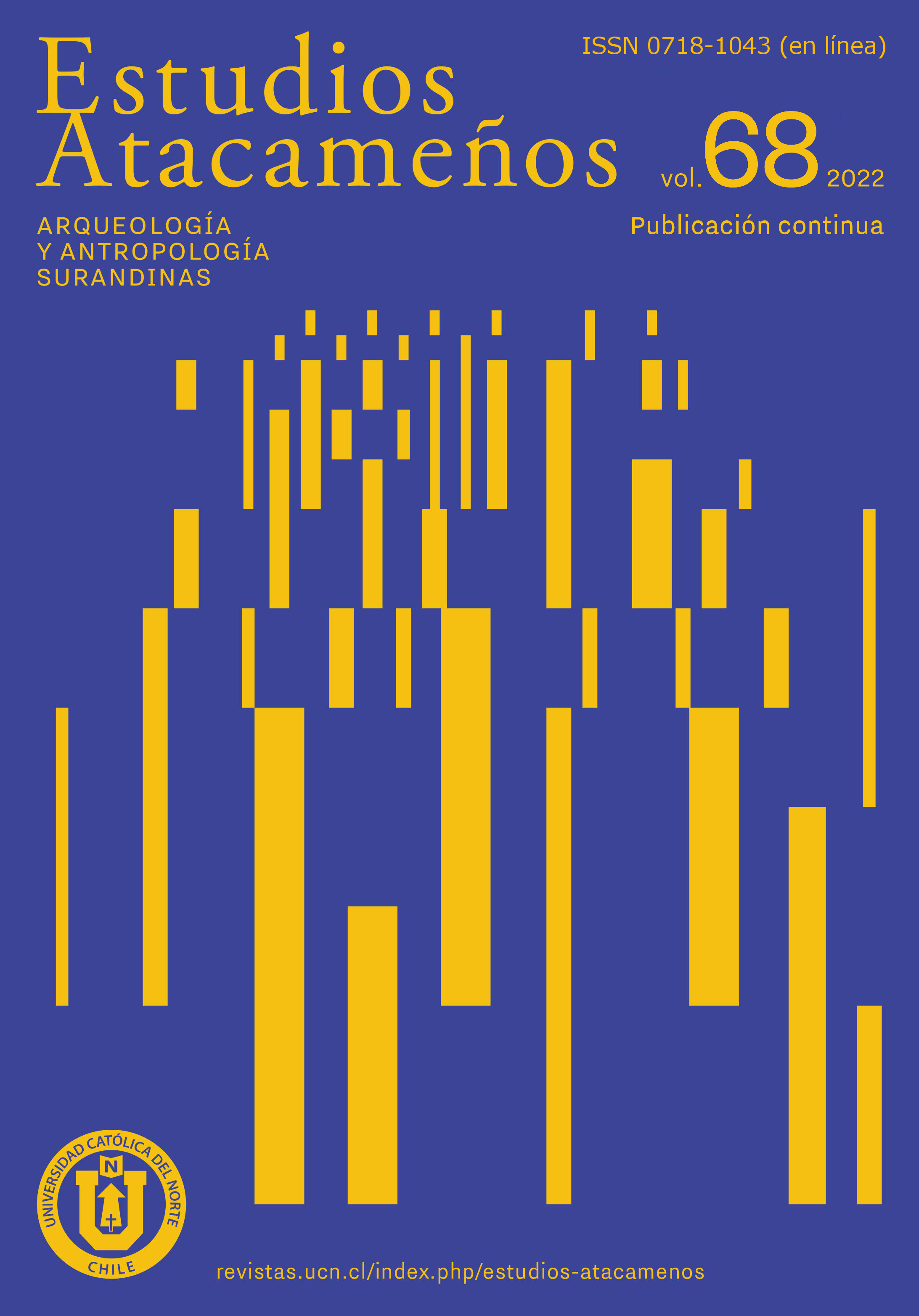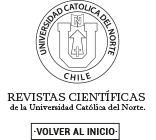Solcor-3
A five century sequence in the periodification
DOI:
https://doi.org/10.22199/issn.0718-1043-2022-0028Keywords:
Northern Chile, Tiwanaku, funerary contexts, periods, circumpuna interactionAbstract
The Solcor-3 archaeological cemetery is one of few systematically excavated sites in San Pedro de Atacama where cultural contexts and complete human remains have been recovered. As such, numerous authors have studied specific aspects of the site or compared it to other sites. Given that there has not yet been a detailed review of the site, we believe a thorough evaluation of its context to be important.
The Association of pottery typologies revealed three phases for the site (Séquitor, Quitor, and Coyo) spanning five centuries of continuous development in the area. The possession of metal objects, particularly during the Coyo phase, sets this community apart as elite among Atacameñan societies. Tiwanaku manifestations are the most common, appearing initially in the Quitor phase and proliferating in the Coyo phase. The quantity and heterogeneity of foreign goods suggest the community was part of a circumpuna network stretching from Tiwanaku in the north to Aguada territories in the south. This article discusses the bioanthropological and social structure of the population.
Downloads
References
Agüero, C. (2003). Componente Tiwanaku vs. componente local en los oasis de San Pedro de Atacama. En V. Solanilla (Ed.), Tejiendo sueños en el Cono Sur. Textiles Andinos: Pasado, presente y futuro. Actas del Simposio ARQ 21. 51º Congreso Internacional de Americanistas (pp. 180-198). Universidad Autonoma de Barcelona. https://bit.ly/3iclyeD
Agüero, C. y Uribe, M. (10-14 de septiembre de 2014). Rethinking the Tiwanaku phenomenon in San Pedro de Atacama through the study of textiles of Solcor 3 and their associated contexts (400-1000 AD) [Presentación] New Directions: Examining the Past, Creating the Future. 14th Biennal Symposium. Textile Society of America Symposium Proceedings. Los Angeles, California, Estados Unidos. https://bit.ly/3gz2E12
Berenguer, J., Deza, A., Roman, A. y Llagostera, A. (1986). La secuencia de Myriam Tarragó para San Pedro de Atacama: un test por termoluminiscencia. Revista Chilena de Arqueología, (5),17-54. https://bit.ly/3U5J625
Bravo, L. y Llagostera, A. (1986). Solcor-3: un aporte al conocimiento de la Cultura San Pedro (Período 500 al 900 d.C.). Chungará (Arica), (16/17), 323-332. https://bit.ly/3Xw3hJf
Costa, M.A. y Llagostera, A. (2014). Leishmaniasis en Coyo Oriente, migrantes transandinos en San Pedro de Atacama. Estudios Atacameños, (47), 5-18. https://doi.org/jnj9
Cocilovo, J.A. y Varela, H.H. (2010). La distribución de la deformación artificial del cráneo en el Area Andina Centro Sur. Relaciones de la Sociedad Argentina de Antropología, (35), 47-68. https://bit.ly/3GLbxiU
Hjorsjo, C.H. y Lindh, J. (1947). Anthropological investigation of the cranial and skeletal material from Dr. Stig Ryden’s archaeological expedition to the Bolivian highlands. En S. Ryden (Ed.), Archaeological Research in the Highlands of Bolivia (Appendix II). Elanders Boktryckeri Aktiebolag.
Hubbe, M., Torres-Rouff, C., Neves, W.A., King, L.M., P., Da-Gloria, P. y Costa, M.A. (2012). Dental health in Northern Chile’s Atacama Oases: evaluating the Middle Horizon (AD 500-1000) impact in local diet. American Journal of Physical Anthropology, 148(1), 62-72. https://doi.org/10.1002/ajpa.22042
Knudson, K.J. (2007). La influencia de Tiwanaku en San Pedro de Atacama: Una investigación utilizando el análisis de isótopos de estroncio. Estudios Atacameños, (33), 7-24. http://dx.doi.org/10.4067/S0718-10432007000100002
Knudson, K.J. y Torres-Rouff, C. (2009). Investigating cultural heterogeneity in San Pedro de Atacama, northern Chile, through biogeochemistry and bioarchaeology. American Journal of Physical Anthropology, 138(4), 473-485. https://doi.org/10.1002/ajpa.20965
Llagostera, A. (1995a). El componente cultural Aguada en San Pedro de Atacama. Boletín del Museo Chileno de Arte Precolombino, (6), 9-34. https://bit.ly/3FaDrnj
Llagostera, A. (1996). San Pedro de Atacama: Nodo de Complementariedad reticular. En X. Albó, M. I. Arratia, J. Hidalgo, L. Núñez, A. Llagostera, M. I. Remy y B. Revesz (Comp.), La Integración Surandina Cinco Siglos después (pp. 17-42). Centro de Estudios Regionales Andinos “Bartolomé de Las Casas”.
Llagostera, A. (2006 a). Contextualización e iconografía de las tabletas psicotrópicas tiwanaku de San Pedro de Atacama. Chungará (Arica), 38(1), 83-111. https://doi.org/ck2zgz
Llagostera, A. (2006 b). San Pedro de Atacama y el sistema reticular de interacción puneña. En H. Lechtman (Ed.). Esferas de interacción prehistóricas y fronteras nacionales modernas: los Andes sur centrales (pp. 303-322). Instituto de Estudios Peruanos e Institute of Andean Research.
Llagostera, A. (2016). Toconao Oriente: referente en la periodificación agroalfarera de San Pedro de Atacama. Estudios Atacameños, (53), 11-32. https://bit.ly/3gAXVMo
Llagostera, A. y Costa-Junqueira, M.A. (2020). Coyo Oriente. Referente del Período Medio en San Pedro de Atacama. Estudios Atacameños, (64), 199-220. https://doi.org/jnkb
Llagostera, A., Torres, C.M. y Costa, M.A. (1988). El Complejo Psicotrópico de Solcor-3 (San Pedro de Atacama). Estudios Atacameños, (9), 61-98. https://doi.org/jnkc
Llagostera, V.B., (2017). Enfermedad degenerativa articular en la población elite y no elite del sitio arqueológico Solcor 3: Período Medio, San Pedro de Atacama, Norte de Chile. Revista del Museo de Antropología, 10(2), 123-130. https://doi.org/10.31048/1852.4826.v10.n2.16803
López-Barrales, R., Hubbe, M., Aspillaga, E., Neves, W.A. y Niemeyer, H.M. (2015). Osteofitosis vertebral en poblaciones prehispánicas de San Pedro de Atacama, Norte de Chile. Estudios Atacameños, (50), 177-194. http://dx.doi.org/10.4067/S0718-10432015000100009
López-Barrales, R., Hubbe, M., Aspillaga, E. y Niemeyer. H. (2015). Niveles de cortisol en cabellos de poblaciones prehispánicas de San Pedro de Atacama y Norte de Chile. Chungará (Arica), 47(4): 679-689. http://dx.doi.org/10.4067/S0717-73562015005000020
Nado, K.L., Marsteller, S.J., King, L.M., Daverman, B.M., Torres-Rouff, C. y Knudson, K.J. (2012). Examining local social identities through patterns of biological and cultural variation in the Solcor ayllu, San Pedro de Atacama, Chile. Chungará (Arica), 44(2), 341-357. http://dx.doi.org/10.4067/S0717-73562012000200010
Pomeroy, E. (2013). Biochemical insights into activity and long distance trade in the south-central Andes (AD 500-1450). Journal of Archaeological Science, 40(8), 3129-3140. https://doi.org/10.1016/j.jas.2013.04.019
Posnansky, A. (1914). Una metrópoli Prehistórica en la América del Sud. Dietrich Reimer. https://bit.ly/3FaH9xf
Ruiz, A., Marrodán, M.D. y Puig-Samper, M.A. (1984). Cráneos normales y deformados de Tiahuanaco. En R. Ramos Galvan y R. M. Ramos Rodriguez (Eds.), Estudios de Antropología Biológica. II Coloquio de Antropología Física Juan Comas, 1982 (pp. 449-474). Universidad Nacional Autónoma de México.
Tarrago, M. (1976). Alfarería típica de San Pedro de Atacama (Norte de Chile). Estudios Atacameños, (4), 37-73. https://doi.org/10.22199/S07181043.1976.0004.00008
Tarrago, M. (1989). Contribución al conocimiento arqueológico de las poblaciones de los oasis de San Pedro de Atacama en relación con los otros pueblos puneños, en especial, el sector septentrional el valle Calchaquí [Tesis de doctorado en Historia], Universidad Nacional de Rosario.
Torres-Rouff, C. (2002). Cranial vault modification and ethnicity in Middle Horizon San Pedro de Atacama, Chile. Current Anthropology, 43(1), 163-171. https://doi.org/10.1086/338290
Torres-Rouff, C. (2008). The influence of Tiwanaku on life in the Chilean Atacama: Mortuary and bodily perspectives. American Anthropologist, 110(3), 325-337. https://doi.org/cpthst
Torres-Rouff, C. y Hubbe, M. (2013).The sequence of human occupation in the Atacama Oases, Chile: A radiocarbon chronology based on human skeletal remains. Latin American Antiquity, 24(3), 330-344. https://doi.org/10.7183/1045-6635.24.3.330
Totora, P.J., Neves, W.A., Costa, M.A. y Bartolomucci, R. (2011). Nonspecific infectious diseases in prehistoric San Pedro de Atacama, Northern Chile. Chungará (Arica), 43(1), 135-146. http://dx.doi.org/10.4067/S0717-73562011000100013
Uribe, M., Santana-Sagredo, F., Maturana, A., Flores, S. y Agüero, C. (2016). San Pedro de Atacama y la cuestión tiwanaku en el norte de Chile: Impresiones a partir de un clásico estudio cerámico y la evidencia bioarqueológica actual (400-1.000 D.C.). Chungará (Arica), 48(2), 173-198. http://dx.doi.org/10.4067/S0717-73562016005000017
Downloads
Published
Issue
Section
License
Copyright (c) 2022 Agustín Llagostera, Maria Antonietta Costa-Junqueira

This work is licensed under a Creative Commons Attribution 4.0 International License.

All works published in Revista Estudios Atacameños (ISSN on line:0718-1043) Revista Estudios Atacameños Creative Commons International 4.0 attribution (CC BY 4.0) licence.
Authors remain the owners of their work and may republish their articles elsewhere without having to request permission, as long as they indicate that the work was originally published in Revista Estudios Atacameños (ISSN on liine:0718-1043).












